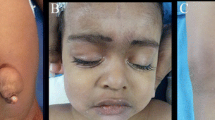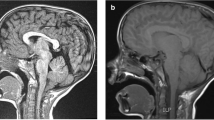Abstract
Introduction
Tectocerebellar dysraphia (TCD) is a rare sporadic malformation associated with severe neurodevelopmental morbidity and high infant mortality. The presence of other ciliopathies worsens the prognosis. Joubert syndrome (JS) is a ciliopathy associated with gene mutations, consisting of midbrain and cerebellum malformations, markedly lack fiber decussation at the level of the pontomesencephalic junction.
Case report
We report the case of a child who was born term with occipital encephalocele (OE), diagnosed with TCD and JS spectrum through computed tomography (CT), magnetic resonance (MR), diffuse tensor imaging (DTI), and clinical findings. She had the OE surgically corrected after spontaneous rupture on the second day after delivery. She developed postoperative ventriculitis, meningitis, and hydrocephalus, successfully treated with intravenous antibiotics and cysto-ventriculostomy, cysto-cisternostomy, third ventriculostomy, and choroid plexus coagulation. G-band karyotyping showed 47, XXX, in all analyzed cells (trisomy X). The infant was followed up for 18 months, presenting, so far, a relatively good outcome.
Conclusion
This is the first case reported in the literature of the association of TCD/OE/JS spectrum (JSS) with trisomy X (XXX).




Similar content being viewed by others
Data availability
All the data reported in this manuscript, including imaging studies and the G-band karyotyping, are available upon reasonable request from the corresponding author (OVF). These data are not publicly available due to the risk of compromising the patient privacy.
References
Padget DH, Lindenberg R (1972) Inverse cerebellum morphogenetically to Dandy-Walker and Arnold-Chiari syndromes: bizarre malformed brain with occipital encephalocele. Johns Hopkins Med J 131(3):228–246
Friede RL (1978) Uncommon syndromes of cerebellar vermis aplasia. II: tectocerebellar dysraphia with occipital encephalocele. Dev Med Child Neurol 20(6):764–772
Martinez-Lage JF, Poza M, Sola J, Soler CL, Montalvo CG, Domingo R et al (1996) The child with a cephalocele: etiology, neuroimaging, and outcome. Childs Nerv Syst 12(9):540–550
Anik I, Koc K, Anik Y, Yildiz DK, Ceilan S (2010) Tectocerebellar dysraphism with vermian encephalocele. J Child Neurol 25(11):1411–1414
Timur H, Sanhal CY, Tokmak A, Muftuoglu KH, Danisman N (2015) Prenatal diagnosis of tectocerebellar dysraphia with occipital encephalocele. J Clin Diagn Res 9(12):QD05–QD07
Poretti A, Singhi S, Huisman TA, Meoded A, Jallo G, Ozturk A, Boltshauser E (2011) Tecto-cerebellar dysraphism with occipital encephalocele: not a distinct disorder, but part of the Joubert syndrome spectrum? Neuropediatrics 42(4):170–174
Shekdar K (2011) Posterior fossa malformations. Semin Ultrasound CT MR 32(3):228–241
Demaerel P, Kendall BE, Wilms G, Halpin SFS, Casaer P, Baert AL (1995) Uncommon posterior cranial fossa anomalies: MRI with clinical correlation. Neuroradiology 37(1):72–76
Ginat DT, Reid R, Frim DM (2016) Imaging assessment of re-exploratory repair of an occipital bone defect-associated tectocerebellar dysraphism via hybrid cranioplasty. Pediatr Neurosurg 51(3):164–166
Naidich TP, Altman NR, Braffman BH, McLone DG, Zimmerman RA (1992) Cephaloceles and related malformations. AJNR Am J Neuroradiol 13(2):655–690
Takanashi J, Sugita K, Barkovich AJ, Takano H, Kohno Y (1999) Partial midline fusion of the cerebellar hemispheres with vertical folia: a new cerebellar malformation? AJNR Am J Neuroradiol 20(6):1151–1153
Chowdhary UM, Ibrahim AW, Ammar AS, Dawodu AH (1989) Tecto-cerebellar dysraphia with occipital encephalocele. Surg Neurol 31(4):310–314
Dehdashti AR, Abouzeid H, Momjian S, Delavelle J, Rilliet B (2004) Occipital extra- and intracranial lipoencephalocele associated with tectocerebellar dysraphia. Childs Nerv Syst 20(4):225–228
Agrawal A, Joharapurkar SR, Khan AU (2010) Tectocerebellar dysraphia manifesting as occipital meningocele associated with congenital melanocytic nevi and pectus excavatum. Iran J Pediatr 20(1):118–122
Nicolas-Jilwan M, Al-Ahmari AN, Alowain MA, Altuhaini KS, Alshail EA (2019) Tectocerebellar dysraphia with occipital encephalocele: a phenotypic variant of the TMEM231 gene mutation induced Joubert syndrome. Childs Nerv Syst 35(7):1257–1261
Roosing S, Romani M, Isrie M, Rosti RO, Micalizzi A, Musaey D et al (2016) Mutations in CEP120 cause Joubert syndrome as well as complex ciliopathy phenotypes. J Med Genet 53(9):608–615
Leibovitz Z, Mandel H, Falik-Zaccai TC, Harouch SB, Savitzki D, Krajden-Haratz K et al (2017) Walker-Warburg syndrome and tectocerebellar dysraphia: a novel association caused by a homozygous DAG1 mutation. Eur J Paediatr Neurol 22(3):525–531
Hildebrandt F, Benzing T, Katsanis N (2011) Ciliopathies. N Engl J Med 364(16):1533–1543
Parisi M, Glass I (2003) Joubert syndrome. In: Adam MP, Ardinger HH, Pagon RA et al (eds) GeneReviews [Internet]. University of Washington, Seattle (last update: 2017). https://www.ncbi.nlm.nih.gov/sites/books/NBK1325/. Accessed [Jul 2020]
Widjaja E, Blaser S, Raybaud C (2006) Diffusion tensor imaging of midline posterior fossa malformations. Pediatr Radiol 36(6):510–517
Lee SK, Dong IK, Kim J, Dong JK, Heung DK, Dong SK, Susumu M (2005) Diffusion-tensor MR imaging and fiber tractography: a new method of describing aberrant fiber connections in developmental CNS anomalies. Radiographics 25(1):53–65
Poretti A, Boltshauser E, Loenneker T, Valente EN, Brancati F, Il’Yasov K, Huisman TA (2007) Diffusion tensor imaging in Joubert syndrome. AJNR Am J Neuroradiol 28(10):1929–1933
Krishnamurthy S, Kapoor S, Sharma V, Prakash A (2008) Tectocerebellar dysraphia and occipital encephalocele: an unusual association with abdominal situs inversus and congenital heart disease. Indian J Pediatr 75(11):1178–1180
Acknowledgments
The authors would like to express their gratitude to the colleagues Rômulo A. S. Marques, MD; Paulo Ronaldo J. Ribeiro, MD, MSc; Juliana C. N. Peixoto, MD; and Fernanda A. O. Peixoto, MD, PhD for their help in the treatment of the child reported in this manuscript. The study was performed with the resources available on an everyday basis in the Division of Neurosurgery, Medical School, Federal University of Goiás.
Author information
Authors and Affiliations
Contributions
All authors contributed to the study conception and design. Material preparation, data collection, and analysis were performed by all authors. The first draft was written by all authors and all authors commented on previous versions of the manuscript. All authors read and approved the final manuscript.
Corresponding author
Ethics declarations
Conflict of interest
None of the authors have conflicts of interest in relation to this manuscript.
None of the authors have been financially supported or have industry affiliations in relation to this manuscript.
Ethics approval
Not applicable.
Consent to participate
Informed consent from the legal responsible was obtained.
Consent for publication
Informed consent for publication was obtained from the legal responsible.
Code availability
Not applicable.
Additional information
Publisher’s note
Springer Nature remains neutral with regard to jurisdictional claims in published maps and institutional affiliations.
Rights and permissions
About this article
Cite this article
Goulart, L.C., Ferreira-Filho, L.A., da Silva, M.M. et al. Tectocerebellar dysraphia and occipital encephalocele associated with trisomy X: case report and review of the literature. Childs Nerv Syst 37, 3257–3260 (2021). https://doi.org/10.1007/s00381-020-04989-6
Received:
Accepted:
Published:
Issue Date:
DOI: https://doi.org/10.1007/s00381-020-04989-6




